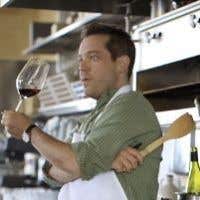This article was also published in the Financial Times.
Dinner at the Heirloom Café in the Mission district of San Francisco left several strong impressions.
The first was of our party of six, three Americans, two Brits and a Frenchman, sitting happily at one end of a large, wooden, communal table facing several bottles of what were to prove to be highly impressive California wines. The view of a room packed with other happy diners in what had formerly been a convenience store was equally pleasurable.
There was the delight of watching Matt Straus (photographed here by Tom Hood), chef turned sommelier turned restaurateur, dashing between his open kitchen, his customers and his cellar downstairs. And of being particularly impressed with the finesse with which he replaced the vegetarian main course served to one of my friends with a no-salt version to comply with her particular diet.
But the strongest impression was made even before we had crossed the Heirloom Café's threshold. I had let my wife out of the taxi first and, after paying the driver, turned to see her reading the menu that was hanging inside the window by the entrance. There was already a smile on her face. As I approached, she turned towards me and gave me the thumbs up.
On closer inspection, the menu revealed two very different sources for her pleasure. The first was a combination of clarity and thoughtful editing. It opened with the US$65 three-course menu for that night, which included a glass of one well-chosen with each course, one French, one German and Egon Müller's Slovakian Riesling Chateau Bela. Below that was a list of half a dozen first and main courses that provided just enough choice but required not too much deliberation.
And in the bottom right-hand corner of the menu was a phrase I had never seen before. Corkage, ie the charge if you bring up to two bottles of your own wine, is US$25 per bottle if the vintage of the wine is 2003 or younger but only US$10 per bottle if the wine is from the 2002 vintage or older. This is a clarion call to all wine collectors in the Bay Area to come and bring their mature bottles, even though Straus has also built up his own impressive wine cellar.
Straus explained that one reason he had initiated this policy was to put off those who make a practice of just stopping at a bottle shop en route to his restaurant. But far more subtle reasons, which also revealed a further aspect of Straus's empathy with his customers, emerged after we had eaten extremely well.
The first course of butter lettuces, avocado, walnuts, herbs and slices of blood orange could not have appeared more appetising to three sun-starved Europeans. The spring of 2013 has been the driest in California for the past 50 years and, while this is bound to have long-term consequences for all farmers and consumers, the immediate results are the freshest-tasting salad leaves. This was followed by a sautéed chicken breast with a herbed bread pudding on a consommé with diced vegetables followed by an almond financier with salted caramel ice cream and candied apples. Three distinguished à la carte dishes were a salad of Dungeness crab and grapefruit; potato gnocchi with pea tendrils; and the first of the season's rhubarb in an ultra thin tart alongside huckleberry ice cream.
What also distinguished this meal was the absence of a usually ubiquitous ingredient in restaurants: bread. I noticed that it had not been served at the outset but that a thick slice of crusty bread appeared balanced on top of the winter vegetable stew with chanterelle mushrooms and asked Straus about this.
His reply seemed far more sensitive than the response I have heard from many other restaurateurs, for whom its service constitutes a double predicament. Firstly, should bread be charged for (and the best is expensive) and, secondly, when should it be served, as it can obviate the need for ordering a more profitable dish?
Straus's reasons for not serving bread range from a growing awareness of what those with coeliac intolerance have to contend with to a personal appreciation that with age the glutens in bread are increasingly difficult to digest. Good food and wine taste even better, Straus believes, without bread, however good it may be.
Bostonian by birth, Straus has come to be the instigator of so many novel ideas at the Heirloom Café via a long apprenticeship. He trained initially as a chef and then worked for several years as a sommelier in Los Angeles before realising that what he most wanted to do was 'to manage a cellar and take pleasure in watching the wines mature'.
Heirloom Café is the hub of all these ambitions. The dining room with an open kitchen, assorted old bottles on a shelf above the front door, and some very carefully chosen furniture and fittings, reinforces the feeling that the room is as lived in as someone's home.
Straus leads from the front and his well-disciplined staff provide excellent support. But all of this has come at a cost, he pointed out. When he took me round the cellar, he showed me a photo of him standing in what was a building site only three years ago. 'Just look how grey my hair has become since I've been a restaurateur – he added, albeit happily.
Heirloom Café 2500 Folsom, San Francisco, CA 94110; tel +1 415 821 2500 www.heirloom-sf.com

